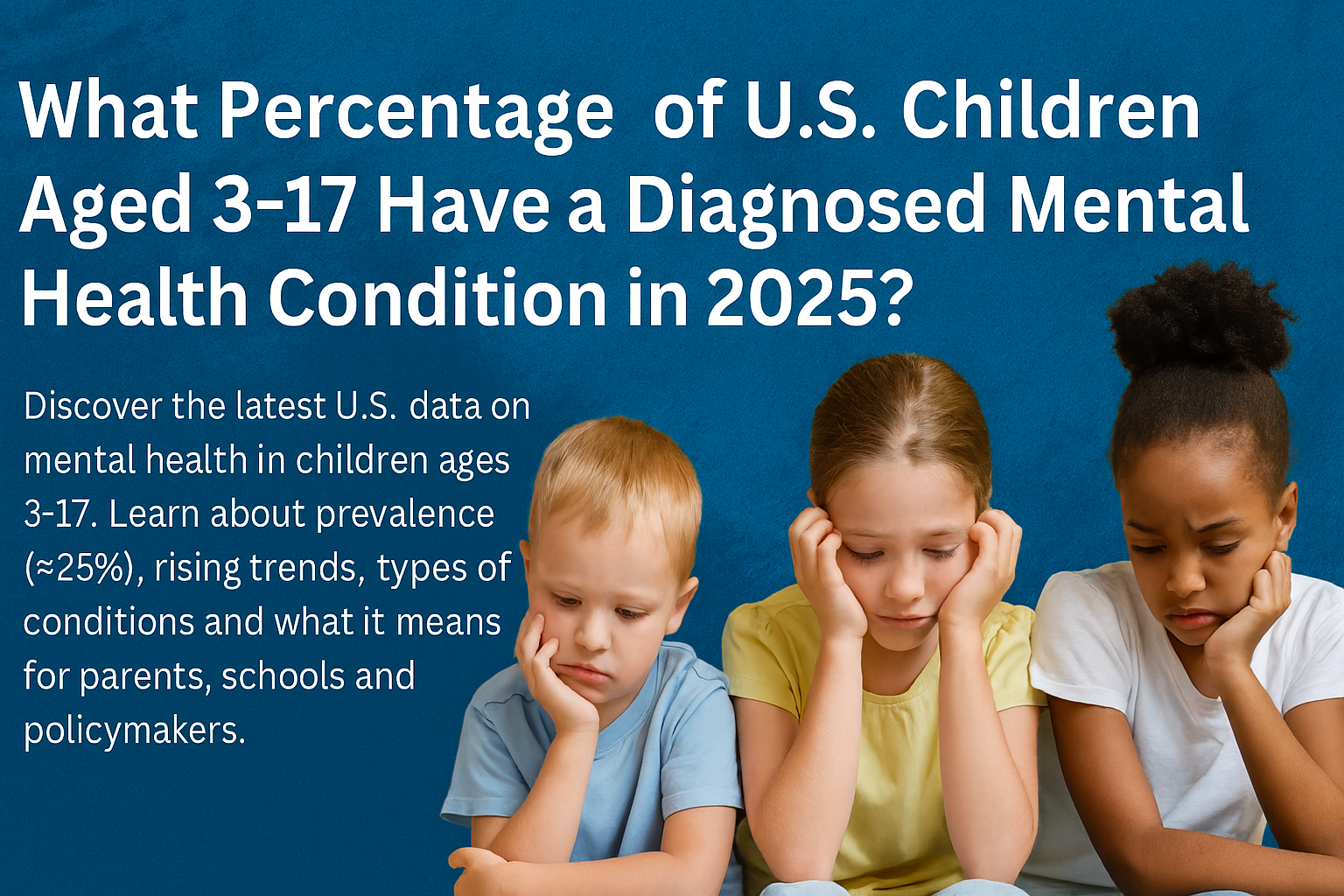What Percentage of U.S. Children Aged 3–17 Have a Diagnosed Mental Health Condition in 2025?”
Mental health is increasingly recognised as a key component of overall health—especially among children. For parents, educators and policy-makers in the U.S., a critical question is: What percentage of children aged 3–17 are diagnosed with a mental, emotional, developmental or behavioural condition? Understanding this figure—and how it’s changing—is essential for planning services, reducing stigma and supporting early-intervention efforts.
What the Data Shows: Prevalence Among Ages 3-17
Overall prevalence
- According to the Centers for Disease Control and Prevention (CDC), 11% of children ages 3–17 had a current, diagnosed anxiety disorder in 2022-23 (9% of males; 12% of females). CDC
- The same data show 8% of children 3–17 had a current, diagnosed behaviour disorder and 4% had a current, diagnosed depression. CDC
- More broadly, data show that “more than 1 in 4 children age 3-17 years had a current, diagnosed mental, emotional, developmental or behavioural (MEDB) condition” in 2022, according to the Health Resources and Services Administration (HRSA). mchb.hrsa.gov
- Survey data indicate that about 25.8% of children aged 3–17 had one or more reported MEDB problems in a 2022 sample. nschdata.org+2CDC+2
- Between 2016 and 2021, prevalence of “mental, behavioural and developmental disorders” (MBDD) for ages 3-17 increased from 25.3% to 27.7%. CDC
Interpretation for 2025
Although exact 2025-only data may not yet be fully released, the most current figures (2022-23) suggest about one in four children aged 3-17 in the U.S. has been diagnosed with some form of mental, emotional, developmental or behavioural condition.
Given the trend of rising prevalence (see above), it is reasonable to project that by 2025 the figure will be at or above ~25-30%.
Breakdown by Condition & Age Group
- Anxiety is the most commonly diagnosed specific condition in children 3-17: ~11%. CDC
- Behaviour disorders: ~8%. CDC
- Depression: ~4% in this age range. CDC+1
- In adolescents ages 12-17, a recent survey shows ~20.3% had a current, diagnosed mental or behavioural health condition (2023 data). mchb.hrsa.gov
Trends: What’s Changing
- The prevalence of MBDD among ages 3-17 increased from 25.3% in 2016 to 27.7% in 2021. CDC
- Among adolescents 12-17, diagnosed conditions increased ~35% between 2016 and 2023 (from ~15.0% to ~20.3%) with particularly large jumps in anxiety (+61%) and depression (+45%). mchb.hrsa.gov
- The data suggest that children in certain demographics (poverty, caregiver mental health issues, etc.) may have higher risk. NCBI+1
Why This Matters
Early-life impact
Mind and behaviour issues in childhood can affect school performance, social relationships, and long-term health. Early diagnosis and support can improve outcomes.
Service & access gap
Even though a significant percentage of children have diagnosed conditions, many do not receive adequate counselling or mental health services. mchb.hrsa.gov+1
Public health policy & education
Reliable prevalence statistics are key for funding mental health programs, school-based services, and community outreach.
Parental/educator awareness
Understanding “1 in 4 children may have a mental/emotional/behavioural condition” helps reduce stigma and encourages families to seek help early.
Implications for Parents, Schools & Policymakers
- For parents: Know the signs (anxiety, behaviour changes, mood shifts) and seek evaluation early if you suspect an issue.
- For schools: Given that ~25% of students may be affected, school programmes for screening, counselling, and referral are essential.
- For policymakers: Allocate resources for child mental health services, integrate behavioural health in pediatric care, and support underserved communities.
- For service providers: Expand access (especially telehealth), emphasise early-intervention, and tailor services for younger age groups (3-7, 8-12, etc.).
Challenges & Areas for Improvement
- Diagnosis vs. treatment gap: Many children who are diagnosed still do not receive timely or adequate services. CDC+1
- Data lag & variation: Some metrics lag by 1-2 years, and different studies define “mental, emotional, developmental or behavioural condition” differently, making direct comparisons tricky.
- Social determinants: Factors like poverty, caregiver stress, housing instability and access to care play a big role in outcomes. Johns Hopkins Public Health
- Stigma & access: Even with increasing awareness of mental health issues, stigma and lack of providers (especially in rural areas) remain barriers.
Conclusion
In the U.S., among children aged 3-17, the prevalence of diagnosed mental, emotional, developmental or behavioural conditions is about 1 in 4 (≈ 25%) or more based on the most recent data (2022-23). With rising trends and evolving awareness, the figure by 2025 is likely to be at or slightly above that threshold.
This high prevalence underscores the importance of early detection, intervention, access to care and policy support. For anyone (parents, educators, policymakers) concerned with child wellbeing, these numbers are a call to action: mental health is not a niche concern—it’s central to child development, education and long-term outcomes.

